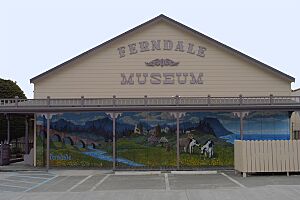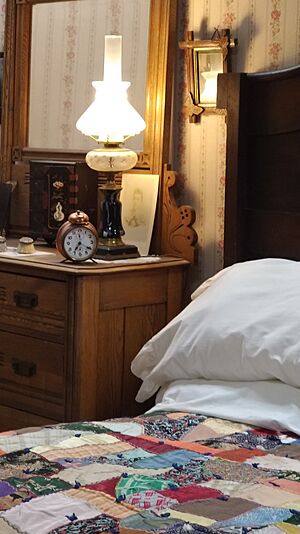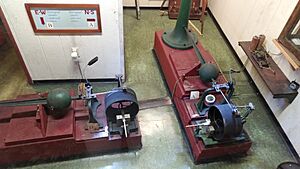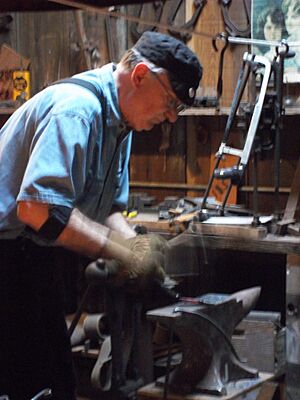Ferndale Museum facts for kids

The Shaw Avenue side of the museum is muraled.
|
|
| Established | 1979 |
|---|---|
| Location | 515 Shaw Avenue, Ferndale, California |
| Type | History |
| Collections | Domestic, Technology, Economic Foundations, Native American, Fine Art, photographs, publications |
| Visitors | 1300 annually |
| Nearest parking | onsite |
The Ferndale Museum is a special place in Ferndale, California. It's a nonprofit museum that keeps and shows old items, papers, and photos. These items tell the story of the area from the time people first settled there during the California Gold Rush until today. The museum even has a working machine called a seismograph that detects earthquakes!
The museum's collection covers a wide area. It includes the lower Eel River Valley, stretching south to the Mattole River Valley, and west to the Pacific Ocean. You can find over 8,000 photos, old copies of the Ferndale Enterprise newspaper, and family papers that are more than 150 years old.
Contents
Museum History
The Ferndale Museum opened its doors on September 22, 1979. Before that, it took two years to get the building ready. The museum has always been located on Shaw Avenue in Ferndale.
What You Can See: The Collections
The museum has many interesting exhibits that show what life was like long ago. You can look into "decorated rooms" that are set up like homes and businesses from the late 1800s and early 1900s. It's like stepping back in time!
In one area, you'll find a working player piano in a Victorian-style living room. There are also tiny, detailed dollhouses that look like Victorian buildings.
You can also see old telephone equipment. There are rows of switchboards where operators used cords to connect phone calls. You can even see working crank telephones! Other exhibits teach about sailing and the sea. There are also items from the first oil well ever drilled in California, which happened in Petrolia in 1865.
The museum also shows how people used to farm, ranch, and work as blacksmiths. You can learn about the lumber (wood) and dairy (milk and cheese) industries too.
Native American Life
There are special exhibits with items made by local Native American tribes. These include baskets from the Wiyot, Yurok, Karuk, and Hupa people. You can also see a woman's buckskin headband, hair ties used by a shaman (a spiritual leader), a smoking pipe, and a gambling drum. Displays about local wildlife help explain what life was like for these communities.
Art and Murals
The museum also displays artwork. You can see paintings from the 1860s by a portrait painter named Stephen William Shaw. There are also photographs by Edna Garrett.
In 2007, a group of artists from Eureka, California painted a large mural on the side of the museum building. This mural shows local history and beautiful scenery.
Special Exhibits
The Bosch-Omori Seismograph
One of the most unique items at the museum is a working Bosch-Omori seismograph. This machine helps detect and record earthquakes. A local resident named Joseph Jordan Bognuda became very interested in earthquakes after living through the big 1906 San Francisco earthquake. This earthquake caused a lot of damage in Ferndale.
Mr. Bognuda worked with the University of California at Berkeley and the United States Coast and Geodetic Survey. Together, they set up a seismograph station in Ferndale. The Bosch-Omori seismograph was developed by scientists named Fusakichi Omori and J.A. Bosch.
These seismographs have two parts, one to detect movement from North to South and another for East to West. Each part has a swinging weight (a pendulum) and a needle that draws on special paper. This paper moves slowly, powered by a clock.
The Ferndale Seismographic Station, called "FER," started working on January 25, 1933. For nearly 30 years, newspapers across the U.S. would call FER for information about California earthquakes. Mr. Bognuda even figured out that constant small wiggles on the seismograph were caused by big waves on the nearby coast. This effect is now called wave-generated microseism.
The FER station stopped operating in 1962 because new technology made it old-fashioned. The university then gave the Bosch-Omori seismograph to the city of Ferndale. In 1981, it moved to the museum, where it still records daily movements today!
Blacksmith Shop and Forge
The museum also has a complete working blacksmith shop and forge. A blacksmith is someone who shapes metal using heat and tools. This exhibit shows hundreds of items that a local blacksmith would have used. Sometimes, you can even see live demonstrations of blacksmithing!
This blacksmith shop is from the 1800s and was originally located in Table Bluff, California. It has over 46 hammers, two anvils (heavy blocks used for shaping metal), tongs, and many other tools. The shop was used from at least 1875 until 1962. You can also see 80 different cattle branding irons, which were used to mark livestock.
Learning About Your Family: Genealogical Research
The museum has a special research room. Here, you can look through old local materials to learn about the area's history and even your own family! They have 145 years of the Ferndale Enterprise newspaper, family records, photo albums, books, and maps. It's a great place to discover the past.
Books and Awards
The museum creates its own books, videos, and a newsletter based on its research.
One of their projects, "Letters Home," won a special award in 2011. It was called the "best contribution to local history" in the United States. This project shared stories about Ferndale's involvement in World War II.
How the Museum Works
In 2022, about 1,300 people visited the museum. The museum is a nonprofit organization. This means it doesn't make money for owners. It is supported by people who become members, donations from visitors, and grants.
The museum has a director who is hired by its board of directors. They also hire people to do research and write their newsletter, Our Story.
See also




